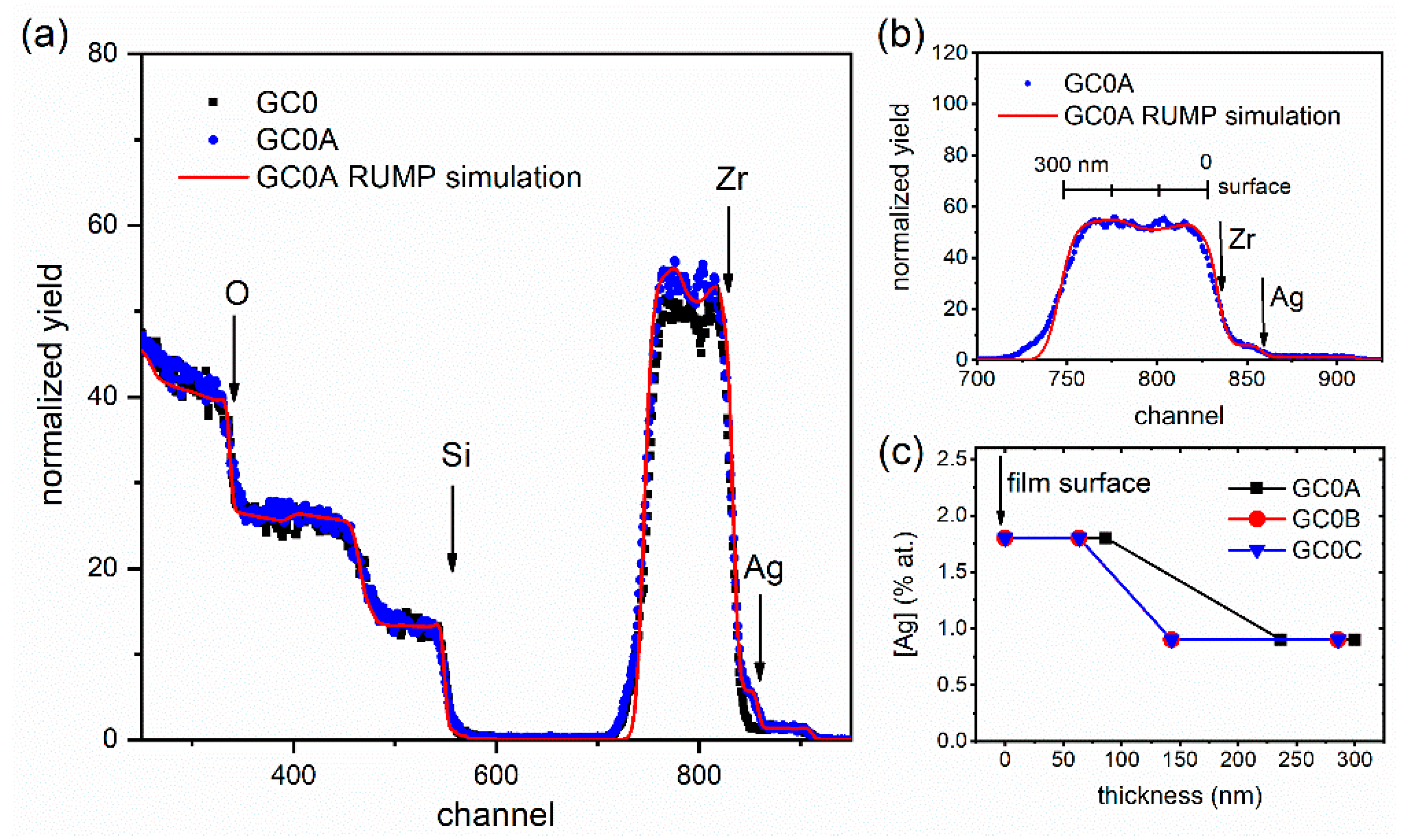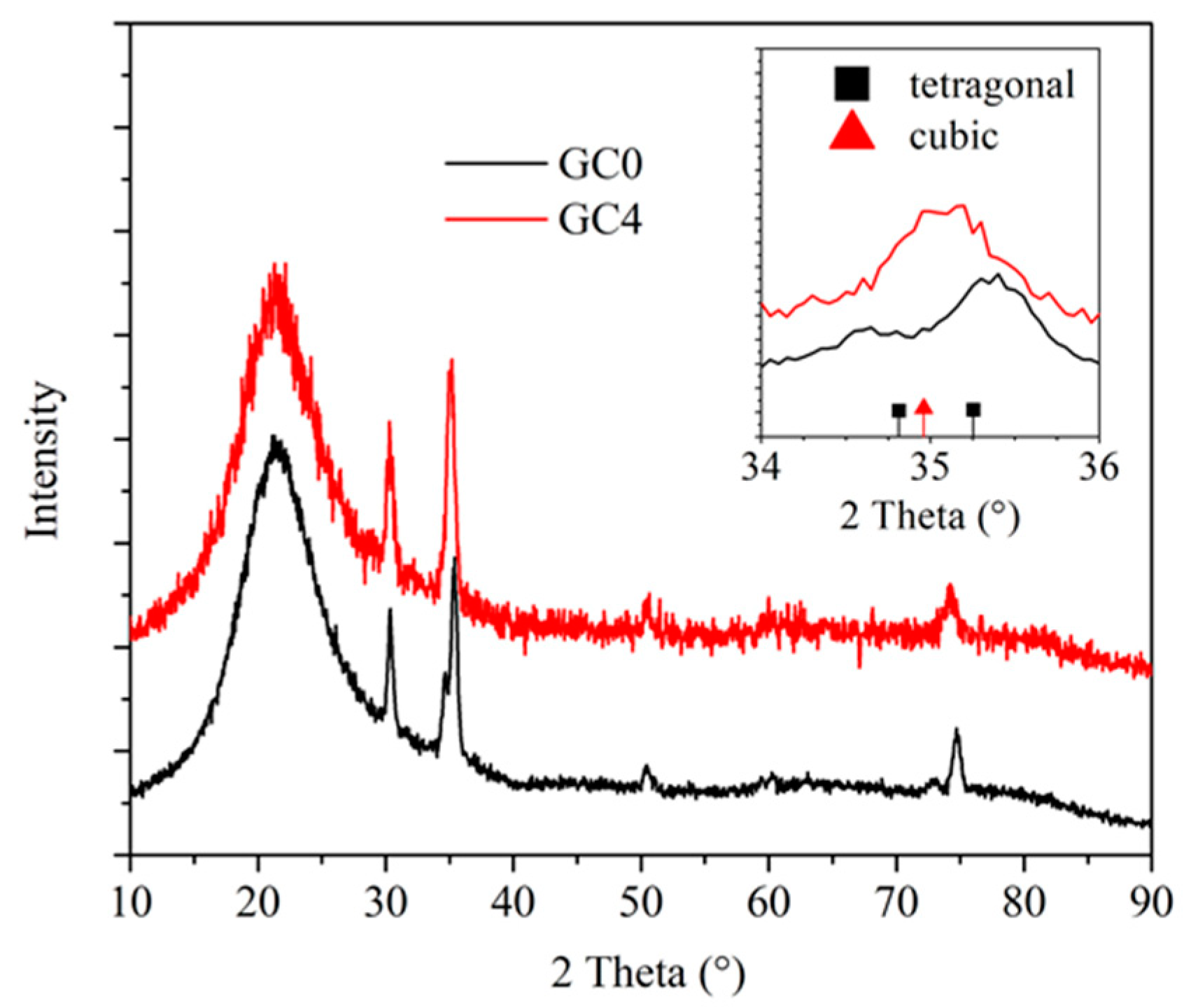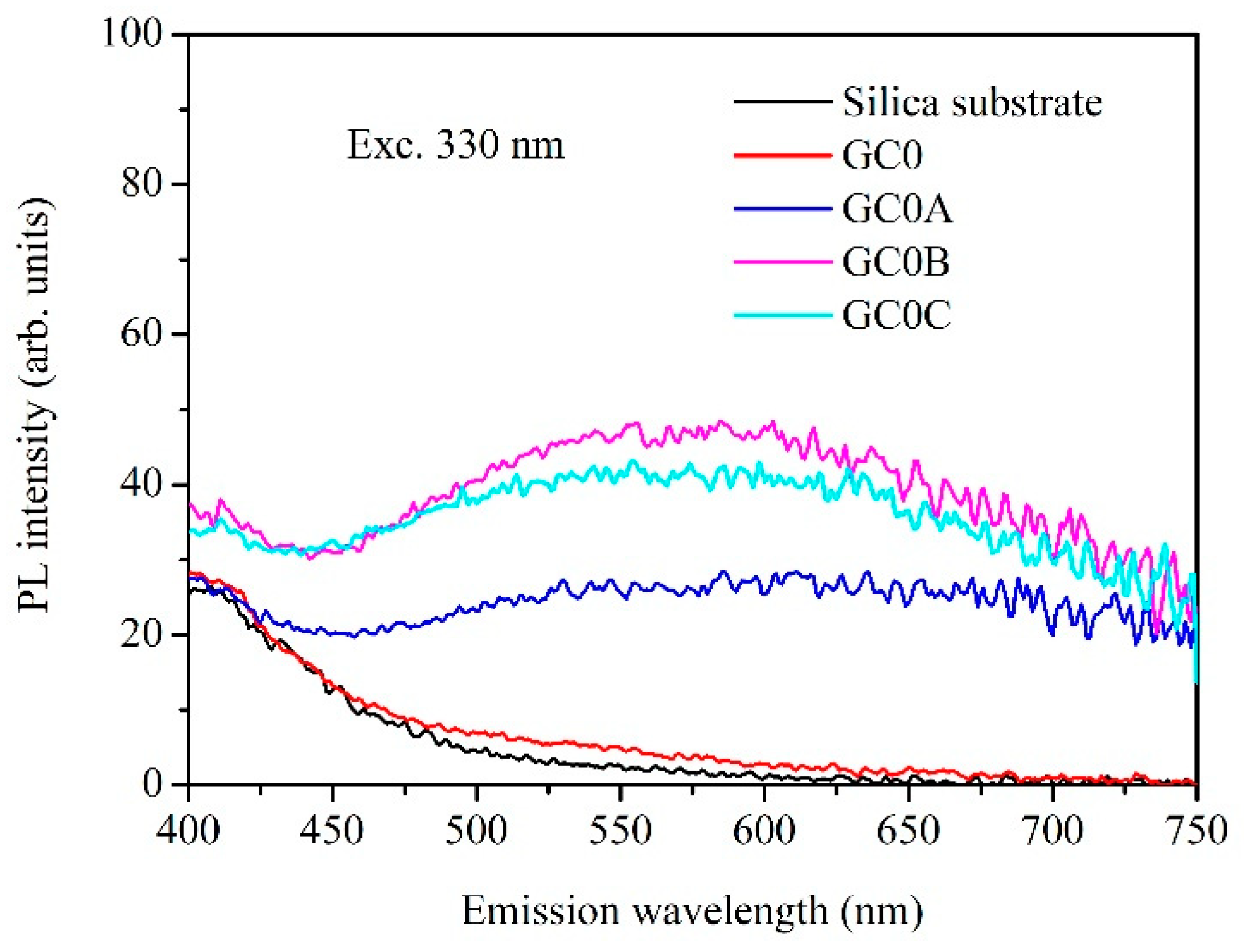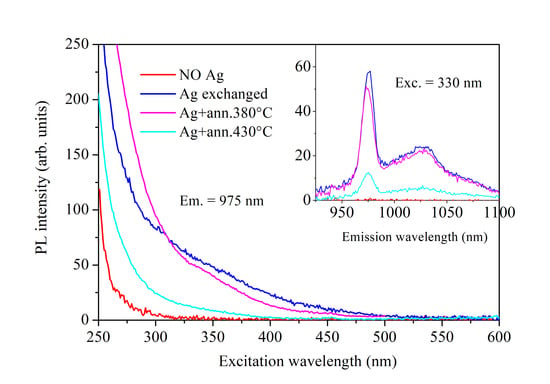Ag-Sensitized NIR-Emitting Yb3+-Doped Glass-Ceramics
Abstract
Featured Application
Abstract
1. Introduction
2. Materials and Methods
- (1)
- TEOS, ethanol (EtOH), H2O and HCl (TEOS:HCl:H2O:EtOH = 1:0.01:2:25), adding 4 mol% YbNO3 for Yb-doped samples;
- (2)
- ZPO, acetylacetone (Acac), ethanol (ZPO:Acac:EtOH = 1:0.5:50);
- (3)
- sodium acetate in methanol (60 mg/mL)
3. Results and discussion
4. Conclusions
Author Contributions
Funding
Conflicts of Interest
References
- Spectroscopic Properties of Rare Earths in Optical Materials; Liu, G., Jacquier, B., Eds.; Springer-Verlag: Berlin, Germany, 2006; ISBN 978-3-540-28209-9. [Google Scholar]
- Jia, X.; Puthen-Veettil, B.; Xia, H.; Yang, T.C.J.; Lin, Z.; Zhang, T.; Wu, L.; Nomoto, K.; Conibeer, G.; Perez-Wurfl, I. All-silicon tandem solar cells: Practical limits for energy conversion and possible routes for improvement. J. Appl. Phys. 2016, 119, 233102. [Google Scholar] [CrossRef]
- Lin, Y.C.; Karlsson, M.; Bettinelli, M. Inorganic phosphor materials for lighting. Top. Curr. Chem. 2016, 374, 1–47. [Google Scholar] [CrossRef]
- Marin, R.; Sponchia, G.; Riello, P.; Sulcis, R.; Enrichi, F. Photoluminescence properties of YAG:Ce 3+,Pr 3+ phosphors synthesized via the Pechini method for white LEDs. J. Nanoparticle Res. 2012, 14. [Google Scholar] [CrossRef]
- Kim, C.H.; Kwon, I.E.; Park, C.H.; Hwang, Y.J.; Bae, H.S.; Yu, B.Y.; Pyun, C.H.; Hong, G.Y. Phosphors for plasma display panels. J. Alloys Compd. 2000, 311, 33–39. [Google Scholar] [CrossRef]
- Liu, Y.; Tu, D.; Zhu, H.; Chen, X. Lanthanide-doped luminescent nanoprobes: Controlled synthesis, optical spectroscopy, and bioapplications. Chem. Soc. Rev. 2013, 42, 6924–6958. [Google Scholar] [CrossRef] [PubMed]
- Enrichi, F.; Riccò, R.; Meneghello, A.; Pierobon, R.; Cretaio, E.; Marinello, F.; Schiavuta, P.; Parma, A.; Riello, P.; Benedetti, A. Investigation of luminescent dye-doped or rare-earth-doped monodisperse silica nanospheres for DNA microarray labelling. Opt. Mater. (Amst.) 2010, 32. [Google Scholar] [CrossRef]
- Enrichi, F. Luminescent amino-functionalized or erbium-doped silica spheres for biological applications. Annals of the New York Academy of Sciences 2008, 1130, 262–266. [Google Scholar] [CrossRef] [PubMed]
- Desurvire, E. Erbium-Doped Fiber Amplifiers: Principles and Applications; John Wiley & Sons Inc.: New York, NY, USA, 1994; ISBN 0471589772. [Google Scholar]
- Moretti, E.; Pizzol, G.; Fantin, M.; Enrichi, F.; Scopece, P.; Nuñez, N.O.; Ocaña, M.; Benedetti, A.; Polizzi, S. Deposition of silica protected luminescent layers of Eu:GdVO4 nanoparticles assisted by atmospheric pressure plasma jet. Thin Solid Films 2016, 598. [Google Scholar] [CrossRef]
- Moretti, E.; Pizzol, G.; Fantin, M.; Enrichi, F.; Scopece, P.; Ocaña, M.; Polizzi, S. Luminescent Eu-doped GdVO4 nanocrystals as optical markers for anti-counterfeiting purposes. Chem. Pap. 2017, 71. [Google Scholar] [CrossRef]
- Chiappini, A.; Zur, L.; Enrichi, F.; Boulard, B.; Lukowiak, A.; Righini, G.C.; Ferrari, M. Glass ceramics for frequency conversion. In Solar Cells and Light Management: Materials, Strategies and Sustainability; Enrichi, F., Righini, G.C., Eds.; Elsevier: Amsterdam, The Netherlands, 2019; ISBN 9780081027622. [Google Scholar]
- Trupke, T.; Green, M.A.; Würfel, P. Improving solar cell efficiencies by down-conversion of high-energy photons. J. Appl. Phys. 2002, 92, 1668–1674. [Google Scholar] [CrossRef]
- Richards, B.S. Enhancing the performance of silicon solar cells via the application of passive luminescence conversion layers. Sol. Energy Mater. Sol. Cells 2006, 90, 2329–2337. [Google Scholar] [CrossRef]
- Enrichi, F.; Armellini, C.; Belmokhtar, S.; Bouajaj, A.; Chiappini, A.; Ferrari, M.; Quandt, A.; Righini, G.C.; Vomiero, A.; Zur, L. Visible to NIR downconversion process in Tb3+-Yb3+codoped silica-hafnia glass and glass-ceramic sol-gel waveguides for solar cells. J. Lumin. 2018, 193, 44–50. [Google Scholar] [CrossRef]
- Bouajaj, A.; Belmokhtar, S.; Britel, M.R.; Armellini, C.; Boulard, B.; Belluomo, F.; Di Stefano, A.; Polizzi, S.; Lukowiak, A.; Ferrari, M.; et al. Tb3+/Yb3+ codoped silica-hafnia glass and glass-ceramic waveguides to improve the efficiency of photovoltaic solar cells. Opt. Mater. (Amst.) 2016, 52. [Google Scholar] [CrossRef]
- Lakshminarayana, G.; Qiu, J. Near-infrared quantum cutting in RE3+/Yb3+ (RE = Pr, Tb, and Tm): GeO2-B2O3-ZnO-LaF3 glasses via downconversion. J. Alloys Compd. 2009, 481, 582–589. [Google Scholar] [CrossRef]
- Katayama, Y.; Tanabe, S. Downconversion for 1µm luminescence in lanthanide and Yb3+-codoped phosphors. In Solar Cells and Light Management: Materials, Strategies and Sustainability; Enrichi, F., Righini, G.C., Eds.; Elsevier: Amsterdam, The Netherlands, 2019; ISBN 9780081027622. [Google Scholar]
- Zur, L.; Armellini, C.; Belmokhtar, S.; Bouajaj, A.; Cattaruzza, E.; Chiappini, A.; Coccetti, F.; Ferrari, M.; Gonella, F.; Righini, G.C.; et al. Comparison between glass and glass-ceramic silica-hafnia matrices on the down-conversion efficiency of Tb3+/Yb3+ rare earth ions. Opt. Mater. (Amst.) 2019, 87, 102–106. [Google Scholar] [CrossRef]
- Falconieri, M.; Borsella, E.; De Dominicis, L.; Enrichi, F.; Franzò, G.; Priolo, F.; Iacona, F.; Gourbilleau, F.; Rizk, R. Study of the Si-nanocluster to Er3+ energy transfer dynamics using a double-pulse experiment. Opt. Mater. (Amst.) 2006, 28. [Google Scholar] [CrossRef]
- Gourbilleau, F.; Dufour, C.; Levalois, M.; Vicens, J.; Rizk, R.; Sada, C.; Enrichi, F.; Battaglin, G. Room-temperature 1.54 μm photoluminescence from Er-doped Si-rich silica layers obtained by reactive magnetron sputtering. J. Appl. Phys. 2003, 94. [Google Scholar] [CrossRef]
- Enrichi, F.; Mattei, G.; Sada, C.; Trave, E.; Pacifici, D.; Franzò, G.; Priolo, F.; Iacona, F.; Prassas, M.; Falconieri, M.; et al. Study of the energy transfer mechanism in different glasses co-doped with Si nanoaggregates and Er3+ ions. Opt. Mater. (Amst.) 2005, 27. [Google Scholar] [CrossRef]
- Enrichi, F.; Mattel, G.; Sada, C.; Trave, E.; Pacific, D.; Franzò, G.; Priolo, F.; Iacona, F.; Prassas, M.; Falconieri, M.; et al. Evidence of energy transfer in an aluminosilicate glass codoped with Si nanoaggregates and Er3+ ions. J. Appl. Phys. 2004, 96. [Google Scholar] [CrossRef]
- Trave, E.; Back, M.; Cattaruzza, E.; Gonella, F.; Enrichi, F.; Cesca, T.; Kalinic, B.; Scian, C.; Bello, V.; Maurizio, C.; et al. Control of silver clustering for broadband Er3+luminescence sensitization in Er and Ag co-implanted silica. J. Lumin. 2018, 197, 104–111. [Google Scholar] [CrossRef]
- Martucci, A.; De Nuntis, M.; Ribaudo, A.; Guglielmi, M.; Padovani, S.; Enrichi, F.; Mattei, G.; Mazzoldi, P.; Sada, C.; Trave, E.; et al. Silver-sensitized erbium-doped ion-exchanged sol-gel waveguides. Appl. Phys. A Mater. Sci. Process. 2005, 80. [Google Scholar] [CrossRef]
- Strohhöfer, C.; Polman, A. Silver as a sensitizer for erbium. Appl. Phys. Lett. 2002, 81. [Google Scholar] [CrossRef]
- Mazzoldi, P.; Padovani, S.; Enrichi, F.; Mattei, G.; Sada, C.; Trave, E.; Guglielmi, M.; Martucci, A.; Battaglin, G.; Cattaruzza, E.; et al. Sensitizing effects in Ag-Er co-doped glasses for optical amplification. In Proceedings of the SPIE—The International Society for Optical Engineering, Volume 5451, Photonics Europe, Strasbourg, France, 18 August 2004. [Google Scholar]
- Ye, S.; Guo, Z.; Wang, H.; Li, S.; Liu, T.; Wang, D. Evolution of Ag species and molecular-like Ag cluster sensitized Eu3+emission in oxyfluoride glass for tunable light emitting. J. Alloys Compd. 2016, 685, 891–895. [Google Scholar] [CrossRef]
- Jiménez, J.A.; Lysenko, S.; Liu, H.; Fachini, E.; Cabrera, C.R. Investigation of the influence of silver and tin on the luminescence of trivalent europium ions in glass. J. Lumin. 2010, 130, 163–167. [Google Scholar] [CrossRef]
- Abbass, A.E.; Swart, H.C.; Kroon, R.E. Effect of silver ions on the energy transfer from host defects to Tb ions in sol-gel silica glass. J. Lumin. 2015, 160, 22–26. [Google Scholar] [CrossRef]
- Li, J.; Wei, R.; Liu, X.; Guo, H. Enhanced luminescence via energy transfer from Ag^+ to RE ions (Dy^3+, Sm^3+, Tb^3+) in glasses. Opt. Express 2012, 20, 10122–10127. [Google Scholar] [CrossRef]
- Enrichi, F.; Cattaruzza, E.; Ferrari, M.; Gonella, F.; Ottini, R.; Riello, P.; Righini, G.C.; Trave, E.; Vomiero, A.; Zur, L. Ag-Sensitized Yb3+ Emission in Glass-Ceramics. Micromachines 2018, 9, 380. [Google Scholar] [CrossRef]
- Enrichi, F.; Belmokhtar, S.; Benedetti, A.; Bouajaj, A.; Cattaruzza, E.; Coccetti, F.; Colusso, E.; Ferrari, M.; Ghamgosar, P.; Gonella, F.; et al. Ag nanoaggregates as efficient broadband sensitizers for Tb3+ ions in silica-zirconia ion-exchanged sol-gel glasses and glass-ceramics. Opt. Mater. (Amst.) 2018, 84, 668–674. [Google Scholar] [CrossRef]
- Lin, H.; Chen, D.; Yu, Y.; Zhang, R.; Wang, Y. Molecular-like Ag clusters sensitized near-infrared down-conversion luminescence in oxyfluoride glasses for broadband spectral modification. Appl. Phys. Lett. 2013, 103. [Google Scholar] [CrossRef]
- Enrichi, F.; Armellini, C.; Battaglin, G.; Belluomo, F.; Belmokhtar, S.; Bouajaj, A.; Cattaruzza, E.; Ferrari, M.; Gonella, F.; Lukowiak, A.; et al. Silver doping of silica-hafnia waveguides containing Tb3+/Yb3+ rare earths for downconversion in PV solar cells. Opt. Mater. (Amst.) 2016, 60. [Google Scholar]
- Enrichi, F.; Cattaruzza, E.; Ferrari, M.; Gonella, F.; Martucci, A.; Ottini, R.; Riello, P.; Righini, G.C.; Trave, E.; Vomiero, A.; et al. Role of Ag multimers as broadband sensitizers in Tb3+/Yb3+ co-doped glass-ceramics. SPIE Proceedings. Fiber Lasers Glas. Photonics Mater. Appl. 2018, 10683. [Google Scholar]
- Afify, N.D.; Dalba, G.; Rocca, F. XRD and EXAFS studies on the structure of Er3+-doped SiO 2-HfO2 glass-ceramic waveguides: Er3+-activated HfO2 nanocrystals. J. Phys. D Appl. Phys. 2009, 42, 115416. [Google Scholar] [CrossRef]
- Zhao, X.; Vanderbilt, D. Phonons and lattice dielectric properties of zirconia. Phys. Rev. B—Condens. Matter Mater. Phys. 2002, 65, 075105. [Google Scholar] [CrossRef]
- Doolittle, L.R. Algorithms for the rapid simulation of Rutherford backscattering spectra. Nucl. Instrum. Methods Phys. Res. Sect. B Beam Interact. Mater. Atoms. 1985, 9, 344–351. [Google Scholar] [CrossRef]
- Enzo, S.; Polizzi, S.; Benedetti, A. Applications of fitting techniques to the Warren-Averbach method for X-ray line broadening analysis. Zeitschrift fur Krist.—New Cryst. Struct. 1985, 170, 275–287. [Google Scholar]
- Wiemer, C.; Lamperti, A.; Lamagna, L.; Salicio, O.; Molle, A.; Fanciulli, M. Detection of the Tetragonal Phase in Atomic Layer Deposited La-Doped ZrO2 Thin Films on Germanium. J. Electrochem. Soc. 2011, 158, G194. [Google Scholar] [CrossRef]
- Cattaruzza, E.; Caselli, V.M.; Mardegan, M.; Gonella, F.; Bottaro, G.; Quaranta, A.; Valotto, G.; Enrichi, F. Ag+↔Na+ion exchanged silicate glasses for solar cells covering: Down-shifting properties. Ceram. Int. 2015, 41, 7221–7226. [Google Scholar] [CrossRef]
- Cattaruzza, E.; Mardegan, M.; Trave, E.; Battaglin, G.; Calvelli, P.; Enrichi, F.; Gonella, F. Modifications in silver-doped silicate glasses induced by ns laser beams. Appl. Surf. Sci. 2011, 257, 5434–5438. [Google Scholar] [CrossRef]
- Borsella, E.; Battaglin, G.; Garcìa, M.A.; Gonella, F.; Mazzoldi, P.; Polloni, R.; Quaranta, A. Structural incorporation of silver in soda-lime glass by the ion-exchange process: A photoluminescence spectroscopy study. Appl. Phys. A 2000, 132, 125–132. [Google Scholar]
- Borsella, E.; Gonella, F.; Mazzoldi, P.; Quaranta, A.; Battaglin, G.; Polloni, R. Spectroscopic investigation of silver in soda-lime glass. Chem. Phys. Lett. 1998, 284, 429–434. [Google Scholar] [CrossRef]




© 2020 by the authors. Licensee MDPI, Basel, Switzerland. This article is an open access article distributed under the terms and conditions of the Creative Commons Attribution (CC BY) license (http://creativecommons.org/licenses/by/4.0/).
Share and Cite
Enrichi, F.; Cattaruzza, E.; Finotto, T.; Riello, P.; Righini, G.C.; Trave, E.; Vomiero, A. Ag-Sensitized NIR-Emitting Yb3+-Doped Glass-Ceramics. Appl. Sci. 2020, 10, 2184. https://doi.org/10.3390/app10062184
Enrichi F, Cattaruzza E, Finotto T, Riello P, Righini GC, Trave E, Vomiero A. Ag-Sensitized NIR-Emitting Yb3+-Doped Glass-Ceramics. Applied Sciences. 2020; 10(6):2184. https://doi.org/10.3390/app10062184
Chicago/Turabian StyleEnrichi, Francesco, Elti Cattaruzza, Tiziano Finotto, Pietro Riello, Giancarlo C. Righini, Enrico Trave, and Alberto Vomiero. 2020. "Ag-Sensitized NIR-Emitting Yb3+-Doped Glass-Ceramics" Applied Sciences 10, no. 6: 2184. https://doi.org/10.3390/app10062184
APA StyleEnrichi, F., Cattaruzza, E., Finotto, T., Riello, P., Righini, G. C., Trave, E., & Vomiero, A. (2020). Ag-Sensitized NIR-Emitting Yb3+-Doped Glass-Ceramics. Applied Sciences, 10(6), 2184. https://doi.org/10.3390/app10062184










